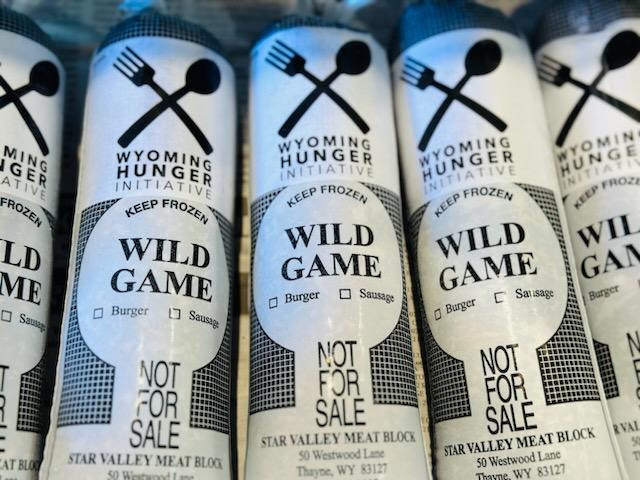Hunters’ Surplus Harvest Helps Hungry Families
Food from the Field, an innovative branch of the Wyoming Hunger Initiative, delivers locally-hunted game to food bank users
- Published In: Other News & Features
- Last Updated: Oct 31, 2023

Through Food from the Field, an operation of First Lady Jennie Gordon’s Wyoming Hunger Initiative, hunters can donate harvested wild game to combat food insecurity in their communities. (Courtesy photo from Sierra Miller/Afton Food Pantry)
By Melissa Thomasma
Special to the Wyoming Truth
Sierra Mitchell pulled away from the Star Valley Meat Block with 300 pounds of ground wild game meat—harvested from two elk, an antelope and a moose—in 150 two-pound packages in her Toyota Highlander. The meat, gifted by local hunters, was destined for the Afton Food Pantry as part of an innovative slice of First Lady Jennie Gordon’s Wyoming Hunger Initiative.
“It’s such an incredible thing to watch patrons’ eyes light up when they come in and see that wild game meat is available on our shelves,” said Mitchell, founder and president of the nonprofit food bank.
Through Food from the Field, hunters can contribute all or part of their bounty to help alleviate food insecurity in Wyoming, where 61,200 people face hunger every day—16,000 of whom are children—according to Feeding America.
“Last year, we had 34 animals donated [yielding] 1,900 pounds of meat across four counties in southwest Wyoming,” Mitchell said. “It’s just gotten bigger as hunters have gotten wind of this way to help.”
Until 2020, Wyoming food banks were legally prohibited from distributing wild game meat, largely due to concerns about illnesses like Chronic Wasting Disease. Gordon sought to change that, and through a collaborative effort with the Wyoming Food Bank, Department of Agriculture and Wyoming Game & Fish Department, the policy was amended and a system implemented to allow contributions of wild-harvested game.

“I am a hunter myself, so I’ve always felt that it was important to share extra bounty if you have it,” Gordon told the Wyoming Truth.
The program’s first year yielded 4,000 pounds of game meat — an amount that soared to 10,000 pounds in 2021. Last year, 20,000 pounds were donated from 347 animals, including deer, antelope, elk, moose and mountain sheep, Gordon said. The program is currently on track to exceed that amount in 2023.
Keeping the harvest local
All hunters can donate their harvest to one of the state’s 11 participating wild game processors. Most processors ask for a $40 donation from the hunter, Mitchell said, but the typical cost for processing an animal is about $300 for a deer and up to $400 for an elk — a bill that Food from the Field covers.
Gordon said partnerships allow meat to be tested for safety and distributed in a timely manner.
“We wouldn’t give something to those in need that we ourselves wouldn’t partake in,” she said. “The Wyoming Game & Fish Department has been integral in getting those samples collected and tested as quickly as possible, so we are ensuring as much safety as we can for folks throughout the state.”
Once the meat is deemed safe for human consumption, it is processed and distributed to over 50 organizations statewide. Mitchell delivers to six food banks in southwest Wyoming, as well as domestic violence shelters and other social service programs.
And when game meat arrives at the Afton Food Pantry, it is gone in a flash.
“Game meat has become the most popular protein we get,” Mitchell said. “When I’m talking to our patrons, they tell me it’s because it’s a piece of home and a bowl of comfort.”
Most clients at the Afton Food Pantry — which has served 28,000 people since opening in 2016 — are elderly and survive on a fixed income. Many are former hunters, Mitchell said, and they are grateful to have a taste of the landscape’s wild bounty again.
“I can’t get these agencies enough of it,” she said. “Trust me, in certain counties, they’re always asking for more.”
Gordon said she was surprised to hear this feedback from Mitchell and other food banks across the state. “If patrons have a choice between beef and elk, about 80% of the time people choose the game meat,” she said.
The rewards of giving back
Melissa Amick, 43, of Cheyenne, who shot her first antelope during the Wyoming Women’s Antelope Hunt in 2020, was happy to gift the meat to Food from the Field.
Amick said it is a powerful way to connect to the landscape and the state’s deep heritage of hunting and fishing, as well as help those in need. “I hate that we have to have it in the first place — that hunger is even a problem — but the fact that so many people are involved is fantastic,” she said.
“Everyone is just one emergency away from being in need of assistance,” said Gordon. “It’s so important to not have judgment towards others if they are in a position to need help. This is a way that many people can pay it forward. We even had a 12-year-old donate his first harvest last year.”
That 12-year-old was, in fact, Mitchell’s eldest son. He successfully filled his tags for a deer, antelope and elk, and he was one of eight youth hunters who gifted their harvest to Food from the Field.
Mitchell said adult hunters appreciate understanding their impact, too: “I let hunters know where their animal went to complete the circle. I want them to know how much that animal makes a difference for food banks like mine, and how rewarding it is to see the families be so excited when game becomes available to them.”
Gordon, a hunter who has personally donated to the program, is pleased that so many Wyomingites have joined forces to alleviate hunger.
“Times are tougher than they even were a few years ago, cost of living has gone up dramatically,” she said. “Some folks are having a tougher time, and helping is what Wyoming is all about.”













